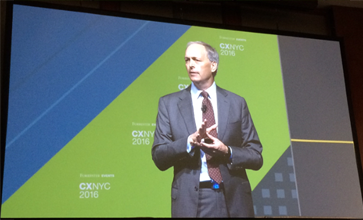Great Minds Gather to Take Stock of Today’s Customer Experience
Forrester CEO George Colony addresses CXNYC 2016 attendees
Last week, I had the pleasure of attending CXNYC 2016, Forrester’s annual event for customer experience leaders, innovators and practitioners, held in New York City. For two days, speakers from among Forrester’s elite analyst group, as well as executives and CX professionals from numerous industries, came together to share their insights into what makes a winning CX strategy, innovative ways to best serve new generations of consumers, revolutionizing centuries-old businesses to embrace new technologies, and other valuable considerations for generating customer loyalty (or, as one executive speaker who maintained Millennials saw “customer loyalty” as reflecting an archaic mindset would put it, “appreciation”).
As a Gold sponsor of the event, NICE was on hand to engage with attendees and demonstrate the company’s leading voice of the customer, customer engagement analytics and customer journey optimization solutions.
NICE’s Philip Gugliotta discusses the benefits of
customer engagement analytics with CXNYC attendees
CX grows up
In one presentation, Forrester’s Rick Parrish discussed his “CX Management Maturity Model,” which maintains an organization must build upon both discipline and empathy (for the customer) to optimize the value of any customer experience project. Such a project must address six key competencies:
- Customer Understanding (ascertaining their motivations, preferences, engagement experience, etc.)
- Prioritization (focusing on the aspects that provide greatest value, or mitigate the most pressing challenges)
- Design (building processes that are flexible, optimizing the customer experience while making efficient use of internal resources)
- Delivery (actually bringing these designed processes to fruition)
- Measurement (to benchmark, and assess continuously)
- Culture (as in, one that is customer-centric, where employees take ownership of CX success)
While Parrish noted that “there is no one path to CXM (customer experience management) maturity,” while “each business is different, and the meaning of ‘maturity’ changes over time,” he echoed the findings of many when asserting CX had grown from an “afterthought” to “a number one priority” for businesses today. (Forrester has committed more than 145,000 man-hours, 30 surveys and 450 reports to studying today’s CX marketplace.)
The Customer Experience Management Maturity Model
Know your customers
Another of Forrester’s speakers, Tony Costa, stressed the importance of gaining complete visibility into a business’s customers when trying to stay ahead of market forces, asking “how do you expose blind spots and stay relevant as customers evolve?”
Seen above: Lots of room for blind spots
Among other anecdotes, Costa discussed the experience of John Deere, a North American provider of farm equipment, as it attempted to expand its tractor business into India. Despite a stellar reputation for building robust equipment, John Deere encountered difficulty selling to that particular market. An ethnographic field study revealed that in India, tractors are seen not merely as farm equipment, but also a basic form of transportation. Their response? John Deere added more seats to its tractors…and sales took off.
The John Deere story offered these valuable lessons about differentiating between making assumptions about customers and knowing the customers:
- Assumptions shape how we think about customers and products.
- Assumptions have a half-life and need to be challenged on a regular basis.
- Ethnographic research is key to challenging and resetting assumptions.
Age of the (demanding) customer
In another presentation, Forrester’s Roxana Strohmenger discussed the effect of evolving technology on customer expectations, echoing much of what has been said regarding the “age of the customer” (i.e. that an abundance of readily available information has empowered the customer to be better informed, more discerning, and well-positioned to get the most bang for his or her buck), and noting this dynamic has been particularly challenging for retailers, where:
- 72% of customers want high quality service.
- 73% want on-time delivery.
- 71% want to find things easily.
- 85% will NOT pay more for a quality experience.
As a result, “customers don’t have a lot of wiggle room to forgive a mistake, or unmet expectations.”
Another speaker, Kevin Cochrane of Jahia, said “digital transformation plus economic collapse has led to very demanding consumers, who want the shortest time to value.” The effects of the 2008 economic downturn, Cochrane asserts, did much to change consumers’ worldview, as losing economic assets (on a personal level, such as with stock devaluation, lost savings, decline in property values, and so on) had the effect of making consumers value their hard-earned money like never before, placing the burden of perceived value on the companies seeking their business.
What customers want, and expect
Solving the customer puzzle
In cultivating the next memorable customer experience, Forrester’s Allegra Burnette cited museums as providing “a great model for engaging the senses, thus providing a memorable customer experience.”
Customer loyalty programs appear to be rather “old hat,” in the eyes of some event speakers. Marriott’s Thom Kozik lamented that “the only thing I’ve paid in the last month that DOESN’T have a loyalty program is my utility bill,” adding “CX needs to be about conveying OUR (the company’s) loyalty to THEM (the customer).”
According to Kozik, establishing a positive company reputation—an expectation regarding the relationship between business and customer—can do wonders in terms of fostering customer loyalty, far more so than any designated “customer loyalty” program.
“Once you nail identity, customers will behave irrationally,” he said, citing Apple as a prime example of a business excelling at this.
Another speaker who might’ve agreed with Kozik was Elena Ford, director of global marketing at Ford Motor Company (and great-great granddaughter of Henry Ford).
“Loyalty is an old-fashioned word,” said Ford. “We aim for appreciation, and this drives our approach to young drivers.”
CX strategy at Ford Motor Company
Check back with our blog next week for “Part II,” as I’ll be discussing what might’ve been the single most prevalent buzzword at Forrester’s event (and, arguably, should be the single most prevalent buzzword in your CX operation).
Were you unable to catch up with NICE in New York? Learn about how we can help you know your customers better, and turn those insights into valuable, actionable data.



